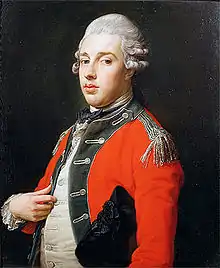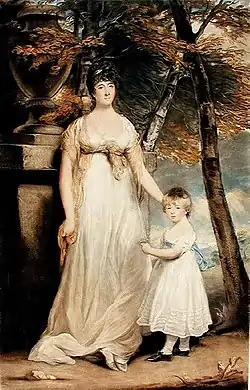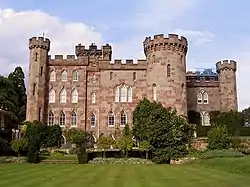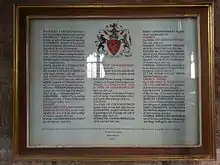George Cholmondeley, 1st Marquess of Cholmondeley
George James Cholmondeley, 1st Marquess of Cholmondeley, KG, GCH, PC (/ˈtʃʌmli/; 11 May 1749 – 10 April 1827), styled Viscount Malpas between 1764 and 1770 and known as The Earl of Cholmondeley between 1770 and 1815, was a British peer and politician.[1]
The Marquess of Cholmondeley | |
|---|---|
 The Marquess of Cholmondeley by Pompeo Batoni, 1772, Houghton Hall, Norfolk. | |
| Lord Steward of the Household | |
| In office 19 February 1812 – 11 December 1821 | |
| Monarch | |
| Prime Minister | The Earl of Liverpool |
| Preceded by | The Earl of Aylesford |
| Succeeded by | The Marquess Conyngham |
| Personal details | |
| Born | George James Cholmondeley 11 May 1749 |
| Died | 10 April 1827 (aged 77) |
| Nationality | British |
| Spouse(s) | Lady Georgiana Charlotte Bertie
(m. 1791) |
| Children | George Cholmondeley, 2nd Marquess of Cholmondeley |
| Parents |
|
.jpg.webp)
Background and education
Cholmondeley was the son of George Cholmondeley, Viscount Malpas, and Hester Edwardes. George Cholmondeley, 3rd Earl of Cholmondeley, was his grandfather.[1] He was a direct descendant of Sir Robert Walpole, the first Prime Minister of Great Britain. He was educated at Eton.[1] In January 1776, Cholmondeley began an affair with the noted beauty Grace Dalrymple Elliot, allegedly taking her up during a Pantheon masquerade ball. Grace was legally separated from her husband, Dr. John Eliot, who was to divorce her several months later. This liaison lasted for three years.[2]
Career
In 1770 he succeeded his grandfather as fourth Earl of Cholmondeley and entered the House of Lords. In April 1783, Cholmondeley was admitted to the Privy Council and appointed Captain of the Yeomen of the Guard in the government of the Duke of Portland, a post he held until December the same year. He remained out of office for the next 29 years, but in 1812 he was made Lord Steward of the Household in Spencer Perceval's Tory administration.[3] He continued in the post after Lord Liverpool became Prime Minister after Perceval's assassination in May 1812, holding it until 1821.
In 1815, Cholmondeley was created Earl of Rocksavage, in the County of Chester, and Marquess of Cholmondeley.[4] He was further honoured when he was made a Knight Grand Cross of the Royal Guelphic Order (Hanoverian Order) in 1819[1] and a Knight of the Garter in 1822.[5] Apart from his political career, he was also Lord-Lieutenant of Cheshire from 1770 to 1783 and Vice-Admiral of Cheshire from 1770 to 1827.
Cholmondeley Sound, in southeast Alaska, was named for him in 1793 by George Vancouver.[6]
Personal life

Lord Cholmondeley married Lady Georgiana Charlotte Bertie,[1] daughter of Peregrine Bertie, 3rd Duke of Ancaster and Kesteven, on 25 April 1791. Through this marriage the ancient hereditary office of Lord Great Chamberlain came into the Cholmondeley family.[7][8]

He inherited Houghton Hall in Norfolk from his great-uncle Horace Walpole in 1797 but preferred to live at Cholmondeley Castle in Cheshire, which had been rebuilt in 1801-04 to his design.
He was friends with the disreputable courtesans Gertrude Mahon, Grace Elliott and Kitty Frederick.[9] According to the betting book for Brooks's, a London gentlemen's club, Cholmondeley once wagered two guineas to Lord Derby, to receive 500 guineas upon having sexual intercourse with a woman "in a balloon one thousand yards from the Earth." It is unknown whether the bet was ever finalised.[10]

Lord Cholmondeley died at age 77 in April 1827, and he was succeeded in his lands, estates and titles by his eldest son George. Lady Cholmondeley died in 1838.
Eighteenth-century English Studies professor and Guggenheim Fellow Arthur Sherbo nominated Lord Cholmondeley as the likely real-life inspiration for the character of Rawdon Crawley in William Makepeace Thackeray's satirical novel Vanity Fair.[11]
Notes
- Cokayne, George E.; Howard de Walden, Thomas Evelyn Scott-Ellis; Warrand, Duncan; Gibbs, Vicary; Doubleday, H. Arthur; White, Geoffrey H. (1910). The Complete Peerage of England, Scotland, Ireland, Great Britain, and the United Kingdom: Extant, Extinct, or Dormant. Volume III, Canonteign to Cutts. London: The St. Catherine Press, Ltd. p. 204.
- Manning, Jo (2005). My Lady Scandalous: The Amazing Life and Outrageous Times of Grace Dalrymple Elliott, Royal Courtesan. New York: Simon and Schuster. ISBN 978-0-7432-6262-0.
- "No. 16580". The London Gazette. 3 March 1812. p. 425.
- "No. 17066". The London Gazette. 30 September 1815. p. 1997.
- "No. 17842". The London Gazette. 10 August 1822. p. 1315.
- U.S. Geological Survey Geographic Names Information System: Cholmondeley Sound
- Notes and Queries (1883 Jan–Jun), p. 42.
- Portcullis Archived 20 December 2008 at the Wayback Machine: Deed of Covenant and Agreement between Lord Willoughby de Eresby, The Dowager Marchioness of Cholmondeley and the Marquis of Cholmondeley re the exercise of the Office of Hereditary Great Chamberlain (16 May 1829). Archived 24 September 2015 at the Wayback Machine
- "Mahon [née Tilson], Gertrude (b. 1752, d. in or after 1808), courtesan and actress | Oxford Dictionary of National Biography". Oxford Dictionary of National Biography (online ed.). Oxford University Press. 2004. doi:10.1093/ref:odnb/64354. Retrieved 11 March 2020. (Subscription or UK public library membership required.)
- L. G. Mitchell's biography of Charles James Fox. Quoted in Google Books
- Sherbo, Arthur (1 December 1955). "A Suggestion for the Original of Thackeray's Rawdon Crawley". Nineteenth-Century Fiction. 10 (3): 211–216. doi:10.2307/3044401. ISSN 0029-0564. JSTOR 3044401.
References
- Debrett, John, Charles Kidd, David Williamson. (1990). Debrett's Peerage and Baronetage. New York: Macmillan. ISBN 978-0-333-38847-1
- Lodge, Edmund. (1877). The Peerage and Baronetage of the British Empire as at Present Existing. London: Hurst and Blackett. OCLC 17221260
External links
- Hansard 1803–2005: contributions in Parliament by the Marquess of Cholmondeley
- Houghton Hall
- Cholmondeley Castle
- Metropolitan Museum of ArtOil painting of Mrs. Grace Dalrymple Elliott by Thomas Gainsborough (British, 1727–1788), which was "apparently commissioned by her lover, the first Marquess of Cholmondeley, and was exhibited at the Academy in 1778."
| Diplomatic posts | ||
|---|---|---|
| Preceded by Hugh Elliot |
British Minister to Prussia 1782 |
Succeeded by Sir John Stepney, Bt |
| Political offices | ||
| Preceded by The Duke of Dorset |
Captain of the Yeomen of the Guard 1783 |
Succeeded by The Earl of Aylesford |
| Preceded by The Earl of Aylesford |
Lord Steward of the Household 1812–1821 |
Succeeded by The Marquess Conyngham |
| Honorary titles | ||
| Preceded by The Earl of Cholmondeley |
Lord Lieutenant of Cheshire 1770–1783 |
Succeeded by The 5th Earl of Stamford |
| Vice-Admiral of Cheshire 1770–1827 |
Succeeded by The 6th Earl of Stamford | |
| Peerage of the United Kingdom | ||
| New creation | Marquess of Cholmondeley 1815–1827 |
Succeeded by George Cholmondeley |
| Peerage of Great Britain | ||
| Preceded by George Cholmondeley |
Baron Newburgh (descended by acceleration) 1815–1821 |
Succeeded by George Cholmondeley |
| Peerage of England | ||
| Preceded by George Cholmondeley |
Earl of Cholmondeley 1770–1827 |
Succeeded by George Cholmondeley |
_coa.png.webp)